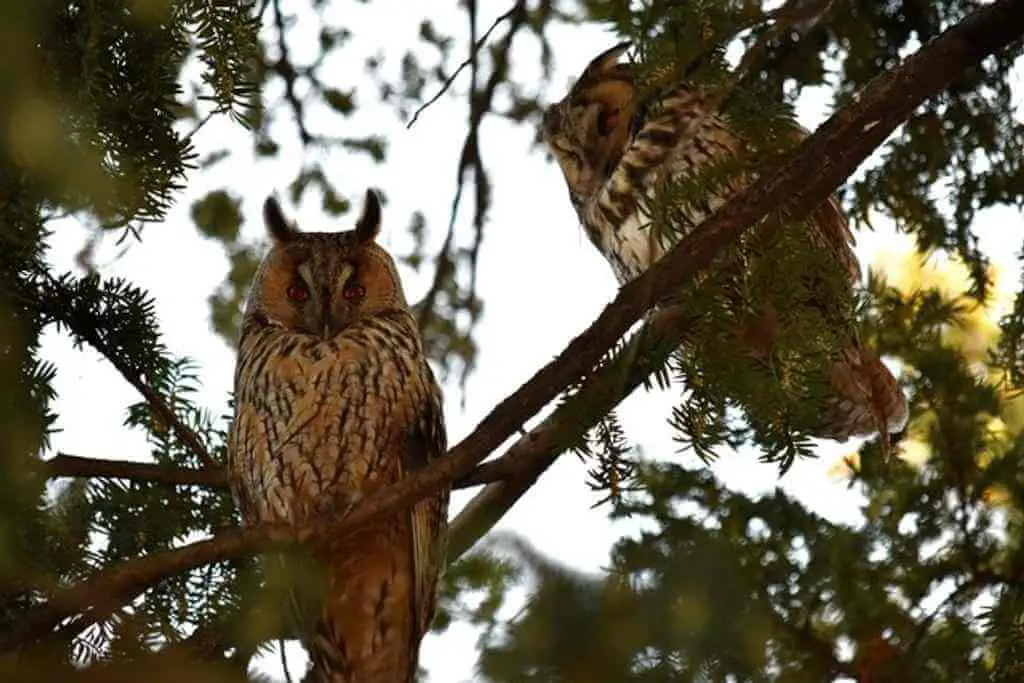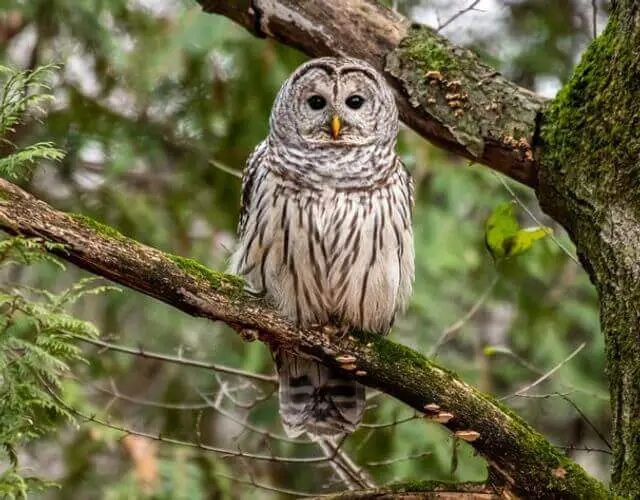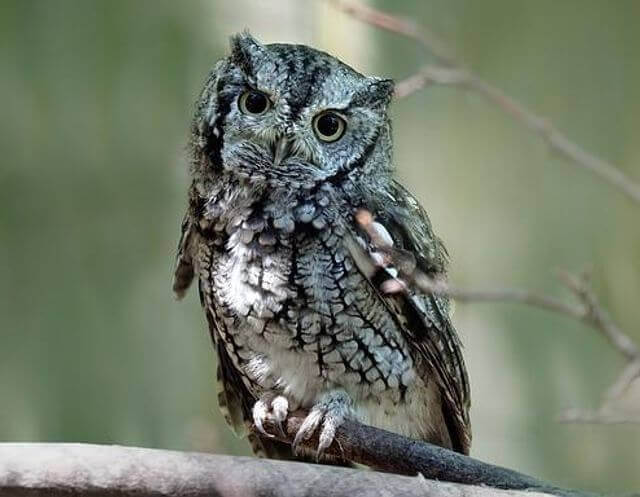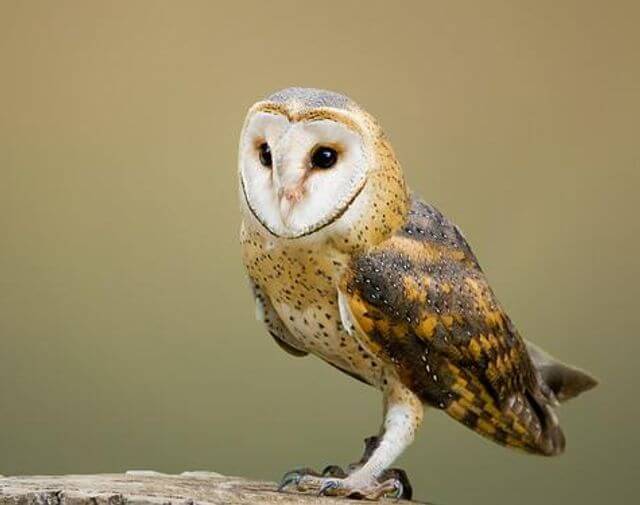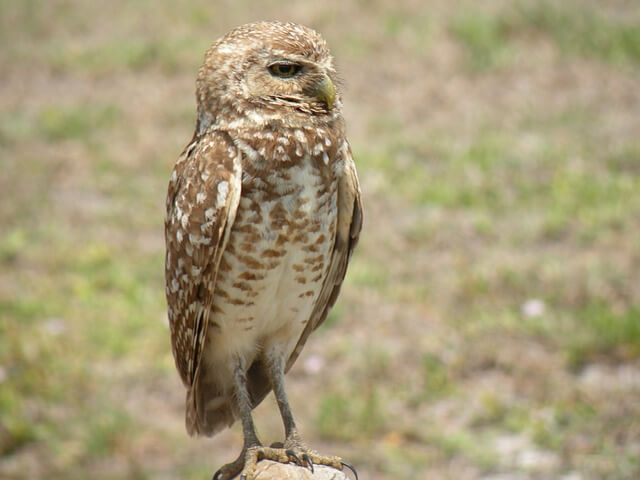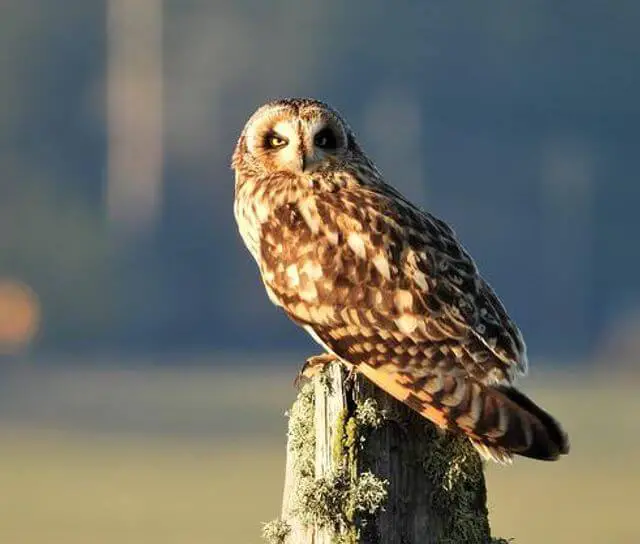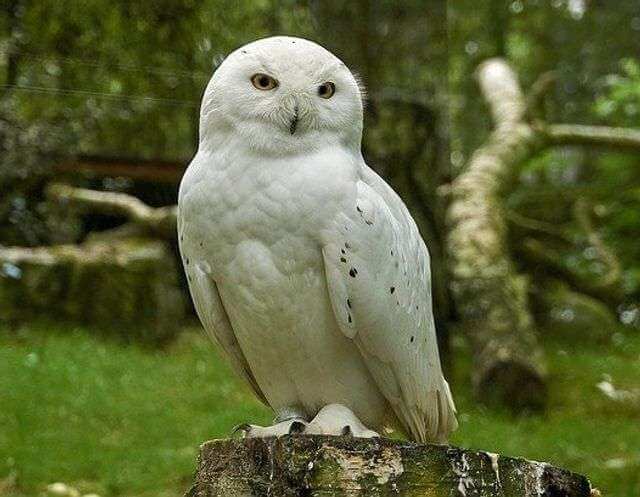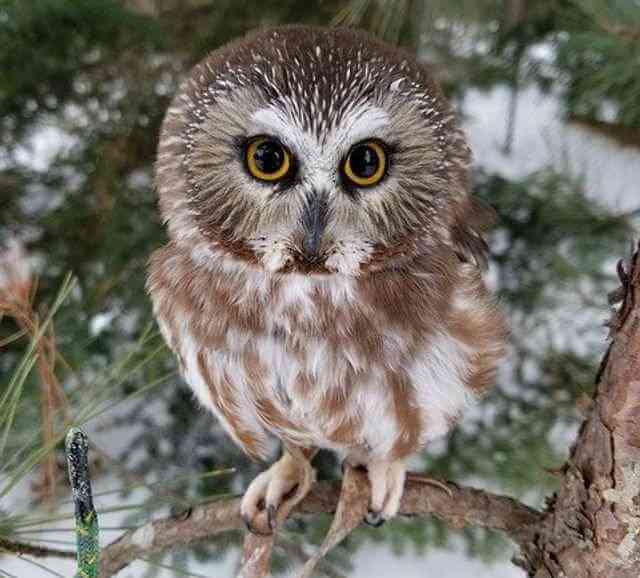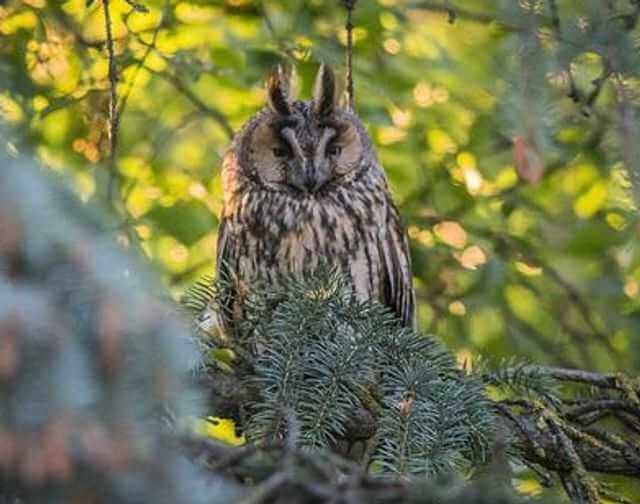Explore the fascinating Types of Owls in Georgia! From the majestic Barred Owl to the tiny Eastern Screech-Owl, Georgia is home to a diverse range of owl species. Join us as we look into their habitats, behaviors, and unique characteristics. Let’s discover the wonderful world of Georgia’s owls together!
Table of Contents
Types of Owls in Georgia
Barred Owl
- Length: 16.9-19.7 in (43-50 cm)
- Weight: 16.6-37.0 oz (470-1050 g)
- Wingspan: 39.0-43.3 in (99-110 cm)
- Scientific Name: Strix varia
- Frequency of Occurrence: 3.36% (Statistic by: eBird)
- Where To Find Them: Some of the best places to see them include the Okefenokee Swamp, the Chattahoochee National Forest, and Fort Mountain State Park.
- How to Attract: Provide a large tree for nesting and hunting. Barred owls prefer tall trees with dense canopies. If you don’t have any large trees in your yard, consider planting one. Provide a source of water. Barred owls need a place to drink and bathe, so make sure you have a bird bath or pond in your yard. Offer plenty of perches. Barred owls like to perch on high branches or poles where they can watch for prey.
The Barred Owl is a medium-sized, brown owl with barring on its chest and belly. This owl is found in North America, from Canada to Mexico, and in Central America. The Barred Owl prefers forested areas near open water, where it can hunt for its prey.
These owls eat a variety of animals, including small mammals, reptiles, amphibians, and fish. They also eat insects and other invertebrates. Barred Owls usually build their nests in tree cavities or in abandoned hawk or squirrel nests.
Great-horned Owl
- Length: 18.1-24.8 in (46-63 cm)
- Weight: 32.1-88.2 oz (910-2500 g)
- Wingspan: 39.8-57.1 in (101-145 cm)
- Scientific Name: Bubo virginianus
- Frequency of Occurrence: 1.08%
- Where To Find Them: Some of these areas include the Chattahoochee National Forest, the Okefenokee Swamp Park, and the Sweetwater Creek State Park. These are all great locations to see these beautiful birds in their natural habitats.
- How to Attract: There are several things you can do to attract great-horned owls to your backyard. One is to provide a source of water, since these owls need a place to drink and bathe. You can also create an area where the owl can hunt by planting small trees, shrubs, and grasses that provide cover for prey animals. And finally, make sure you have plenty of large trees for the owl to perch on.
The Great-horned owl is a large, powerful owl found in North and South America. This owl is the most common owl in North America and can be found in a wide variety of habitats, including forests, deserts, and urban areas. The great-horned owl preys on a wide variety of animals, including rodents, rabbits, birds, and even skunks.
This owl is also known to take advantage of carrion. Great-horned owls are typically monogamous and mate for life. Nests are typically constructed in trees, but they have been known to use cliff ledges and buildings as well.
Related Post: 35 Fun Facts About The Great Horned Owl (Detailed)
Eastern Screech Owl
- Length: 6.3-9.8 in (16-25 cm)
- Weight: 4.3-8.6 oz (121-244 g)
- Wingspan: 18.9-24.0 in (48-61 cm)
- Scientific Name: Megascops asio
- Frequency of Occurrence: 0.5525%
- Where To Find Them: In Georgia, they can be seen in a variety of locations, including the Okefenokee Swamp, the Chattahoochee National Forest, and Black Rock Mountain State Park.
- How to Attract: There are several things you can do to attract screech owls to your yard. One of the most important is to provide a safe place for them to nest. This could be a natural tree cavity, a wooden box that you install yourself, or an artificial nesting platform. You can also provide food for screech owls by putting out a dish of fresh water and some live insects or mice.
The Eastern Screech Owl is a small owl that lives in eastern North America. They are usually found in woodlands, parks, and other areas with trees. These owls eat mostly insects, but they also eat small mammals, amphibians, and reptiles.
The Eastern Screech Owl can be found in a variety of habitats, including forests, marshes, swamps, and even urban areas. They are known to nest in tree cavities or abandoned buildings.
Barn Owl
- Length: 12.6-15.8 in (32-40 cm)
- Weight: 14.1-24.7 oz (400-700 g)
- Wingspan: 39.4-49.2 in (100-125 cm)
- Scientific Name: Tyto alba
- Frequency of Occurrence: 0.1208%
- Where To Find Them: Barn owls are also commonly seen near open water sources, such as lakes and rivers. Some good places to see barn owls in Georgia include the Okefenokee Swamp National Wildlife Refuge, the Tallulah Gorge State Park, and the Chickamauga and Chattanooga National Military Park.
- How to Attract: One way to attract barn owls is to provide them with a place to nest. You can do this by building or installing a nest box in an appropriate location. The box should be made out of wood and have an opening on the side or front that is at least 8 inches wide and 12 inches high. It is important to install the box at least 15 feet off the ground and facing away from prevailing winds. Another way to attract barn owls is to provide them with food.
Barn Owls are found throughout the world in open habitats such as fields, meadows, prairies, and deserts. They also inhabit woodlands and agricultural areas. Barn Owls have been known to live in urban areas, but they prefer more rural settings.
Barn Owls usually roost and nest in barns, but they will use other abandoned buildings or tree cavities. These owls mainly eat small mammals such as rodents, but they will also prey on birds, amphibians, reptiles, and insects.
Burrowing Owl
- Length: 7.5-9.8 in (19-25 cm)
- Weight: 5.3 oz (150 g)
- Wingspan: 21.6 in (55 cm)
- Scientific Name: Athene cunicularia
- Frequency of Occurrence: 0.0222%
- Where To Find Them: They prefer areas with short grass and an abundance of prey. The best places to see Burrowing Owls in Georgia are along the Flint River near Albany and in the Okefenokee Swamp.
- How to Attract: If you want to attract a burrowing owl to your backyard, you need to provide an open area with short grasses or prairies for them to hunt in. You can also create a burrow for them by digging a hole about 18 inches deep and filling it with straw, leaves, or other soft materials. Be sure to check the hole regularly to make sure it is still intact and hasn’t been filled in by animals or humans.
Burrowing Owls are a unique owl species found throughout North and South America. They are the only owl species that lives in prairies, grasslands, and open woodlands. Burrowing Owls have also been known to live in urban areas near people.
These owls are ground nesters and typically build their nests in holes dug by other animals such as prairie dogs or badgers. Burrowing Owls eat mostly insects but will also consume small mammals, reptiles, and amphibians.
Related Post: Really Cool Burrowing Owl Facts That Will Amaze You!
Short-eared Owl
- Length: 13.4-16.9 in (34-43 cm)
- Weight: 7.3-16.8 oz (206-475 g)
- Wingspan: 33.5-40.5 in (85-103 cm)
- Scientific Name: Asio flammeus
- Frequency of Occurrence: 0.0210%
- Where To Find Them: In Georgia, the best places to see them are Blackbeard Island National Wildlife Refuge, Okefenokee Swamp Park, and Watson Mill Bridge State Park.
- How to Attract: There are a few things you can do to attract short-eared owls to your property. One is to provide an area where they can perch, such as a tall tree or fence post. You can also create a feeding area for them by putting out small mammals or other prey items. If you live in an area where these owls are known to reside, keep an eye out for them and enjoy watching these beautiful creatures up close!
The Short-eared owl is a medium-sized owl that inhabits open habitats in North America, Europe, and Asia. They are usually seen perched on the ground or on a low perch such as a fence post or tree.
These owls eat mostly small rodents, but also consume other small prey such as insects, reptiles, and amphibians. The short-eared owl is well-adapted to living in open habitats and can be found in fields, prairies, marshes, and deserts.
Snowy Owl
- Length: 20.5-27.9 in (52-71 cm)
- Weight: 56.4-104.1 oz (1600-2950 g)
- Wingspan: 49.6-57.1 in (126-145 cm)
- Scientific Name: Bubo scandiacus
- Frequency of Occurrence: 0.0166%
- Where To Find Them: One place to see them is near the shores of Lake Lanier. They can also be seen in the agricultural areas around Tifton and Cordele. Finally, they can sometimes be spotted in the marshes near Savannah.
- How to Attract: One way to attract snowy owls is to provide a perch for them. A good place to put up a perch is near a body of water, such as a pond or lake. The owls will use the perch to hunt for food and observe their surroundings. You can also provide food for the owls by putting out a dish of fresh mice or other small animals.
Snowy owls are one of the most widespread owl species in the world. They can be found in the Arctic tundra of North America, Europe, and Asia. These owls prefer open habitats with plenty of exposed perches for hunting.
In North America, they are most commonly found in open fields, meadows, and prairies. Snowy owl’s diet consists mostly of small rodents such as lemmings and voles, but they will also eat birds, eggs, and insects.
Related Post: 48 Fun Facts About Snowy Owls (with Photos, ID & Info)
Northern Saw-whet Owl
- Length: 7.1-8.3 in (18-21 cm)
- Weight: 2.3-5.3 oz (65-151 g)
- Wingspan: 16.5-18.9 in (42-48 cm)
- Scientific Name: Aegolius acadicus
- Frequency of Occurrence: 0.0035%
- Where To Find Them: In Georgia, they are typically found in the northeast and northwest parts of the state. Some good locations to see these owls include the Chattahoochee National Forest and the Tallulah Gorge State Park.
- How to Attract: If you are looking to attract a Northern Saw-whet Owl to your backyard, there are a few things you can do. One thing you can do is provide a roosting box for the owl. The box should be made from wood and have an entrance hole that is about 4 inches wide. You can also provide a water dish for the owl and place it in a sheltered location. Another thing you can do to attract Northern Saw-whet Owls is to create a wildlife habitat garden. This type of garden will provide the owls with food and shelter.
The Northern saw-whet owl is America’s smallest owl. It ranges from Alaska to southern California and east to the Great Lakes. Saw-whets live in dense forests, preferring coniferous forests but also living in deciduous forests.
They like to nest in trees or on cliffs, but will also use buildings or other man-made objects. These owls eat mostly small mammals such as mice, rats, and voles, but they will also eat birds, insects, and amphibians.
Related Post: What is the Smallest Owl in North America?
Long-eared Owl
- Length: 13.8-15.8 in (35-40 cm)
- Weight: 7.8-15.3 oz (220-435 g)
- Wingspan: 35.4-39.4 in (90-100 cm)
- Scientific Name: Asio otus
- Frequency of Occurrence: 0.0008%
- Where To Find Them: Long-eared owls can be seen in the following areas or locations in Georgia, USA: The Chattahoochee National Forest, The Okefenokee National Wildlife Refuge, The Piedmont National Wildlife Refuge, Harris Neck National Wildlife Refuge, Cumberland Island National Seashore.
- How to Attract: The best way to attract a long-eared owl is to provide a habitat that suits their needs. They prefer woodland edges and open areas with tall grasses or shrubs for nesting and hunting. A few dead trees or large limbs for perching are also important. Providing a water source is also beneficial. Since these owls are not commonly seen, it may take some time before they visit your yard. However, if you provide the right habitat conditions, they may eventually show up.
The Long-eared Owl is a medium-sized owl that is found in North America, Europe, Asia, and Africa. In the United States, they range from Alaska to California and east to New York.
They live in open areas such as prairies, agricultural fields, woodlands edges, and wetlands. The Long-eared Owl feeds primarily on small rodents such as mice, voles, and shrews. They also eat insects, birds, and other small prey.
Frequently Asked Questions
What is the most common owl in Georgia?
The most common owl in Georgia is the Barred Owl. It has a frequency of occurrence of 3.36%. The next most common owl is the Great-horned Owl, which has a frequency of occurrence of 1.08%. The least common owl is the Long-eared Owl, which has a frequency of occurrence of 0.0008%.
What kind of owls are native to Georgia?
There are nine types of owls that are native to Georgia. These owls include the Barred Owl, Great Horned Owl , Barn Owl, Burrowing Owl, Eastern Screech Owl, Northern Saw-Whet Owl, Short-Eared Owl, Snowy Owl, Long-eared Owl
What attracts owls to your property?
Some of the most common things that draw owls to a property are: plentiful prey, shelter, and water. If you have an area on your property that is rich in prey (e.g., rodents, rabbits, snakes), then owls are likely to take notice.
Owls also appreciate areas with plenty of trees and other cover for shelter, as well as places where they can find water to drink or bathe in.
If you are hoping to attract owls to your property, it is important to provide all of these things. You can do this by creating a natural habitat for them or by placing owl houses in strategic locations.
What sounds do owls make in Georgia?
There are many types of owls that live in Georgia, and each one has a different call. For example, the barred owl has a deep hooting noise, while the eastern screech owl has a high-pitched call that sounds.
The great horned owl is probably the most well-known owl in Georgia, and it makes a variety of sounds including hoots, hisses, and growls.
Do owls eat squirrels?
Yes, owls are oppurtunistic hunters, and will eat squirrels if they are available. However, it’s not a common occurrence because there are other prey options that are easier to catch for owls. Squirrels may be more likely to be prey for owls in areas where there are few other food options available.
Are owls rare in Georgia?
Owls are not typically considered a common sighting in Georgia. In fact, many people may be surprised to learn that owls do in fact reside in the state. There are many different species of owl that can be found in Georgia, and while they may not be rare, they are not as common as some of the other bird species in the area. Some of the most common owl species found in Georgia include the great horned owl, barred owl, and eastern screech owl.
Are owls protected in GA?
In Georgia, owls are protected under the Migratory Bird Treaty Act. This means that it is illegal to kill, capture, or possess an owl without a permit from the Georgia Department of Natural Resources. The act also requires anyone who disturbs an owl’s nest to take necessary steps to ensure the safety of the eggs or young.
Related Post: 35 Most Common Birds in Georgia (with Photos, ID & Info)

